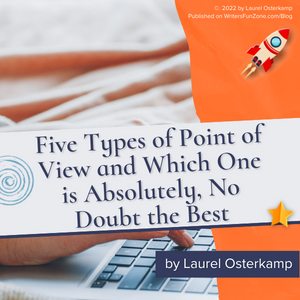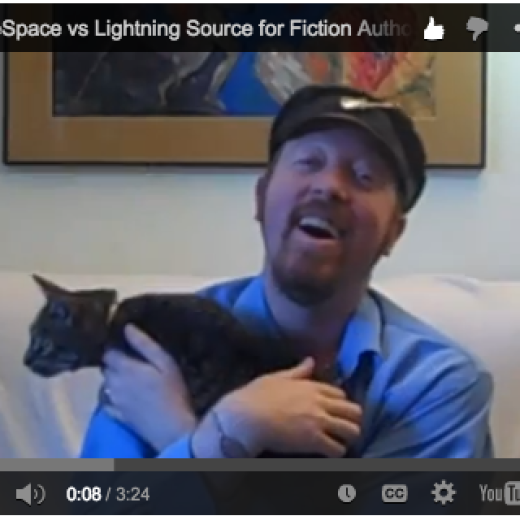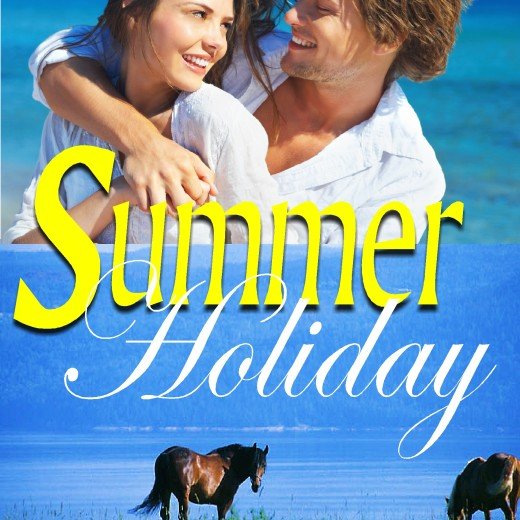Five Types of Point of View and Which One is Absolutely, No Doubt the Best by Laurel Osterkamp
 Let’s welcome back Laurel Osterkamp as she shares with us “Five Types of Point of View and Which One is Absolutely, No Doubt the Best.” Enjoy!
Let’s welcome back Laurel Osterkamp as she shares with us “Five Types of Point of View and Which One is Absolutely, No Doubt the Best.” Enjoy!
***
You have a great idea for a piece of fiction. You sit down at your computer, and begin to write.
But what about THE MOST IMPORTANT DECISION you will make about your story or novel?
That is, which point of view will you choose?
There are more options than you might think. I’ve listed them here in order of how often I believe they are used.
Third Person Limited
With third-person limited, we get a lot of insight into a specific character’s thoughts and motivations, yet the story is still told by an unseen narrator.
Third person-limited gives a writer flexibility yet still allows for intimacy.
First Person
My personal favorite.
In fact, for a long time, I hated to write in any POV other than first person.
I like speaking directly to my reader, through the voice of my protagonist. It just feels so easy and comfortable, and I can “get to know” my main character in a way that writing in any other point of view won’t allow.
Lately I’ve learned to break out of my first-person rut.
Third Person Omniscient
Personally, I would never use an all-knowing narrator.
For me, it’s too difficult to focus. But some authors, like Jane Austen, achieve it beautifully.
You might be thinking, Wait. Isn’t Pride and Prejudice written in third-person-limited?
Actually, no.
While a lot of what we see and hear is filtered through Lizzie, not all of it is. Consider the first line:
“It is a truth universally acknowledged, that a single man in possession of a good fortune, must be in want of a wife.”
Pride and Prejudice by Jane Austen
While being a love story, is more importantly a commentary on society. Thus, the narration must have a universal tone.
Second Person
Ahh, the elusive second person.
I used to tell my high school creative writing students that second-person is the hardest POV to do well, but when it is done well, it’s incredibly effective.
Most authors don’t use second person, unless they’re writing a choose-your-own-adventure story. But I love second-person, at least for short pieces.
I don’t think I’d want to read an entire novel where “you” are the protagonist, but one of my favorite short stories, You Could Be Anyone, from Melissa Bank’s Girls Guide to Hunting and Fishing, uses second-person in a mind blowing way.
At the end, “you” realize that the story could not have been told from any other perspective.
First Person Plural
In first-person-plural, no single narrator is identified. Instead, the narrator is a group that speaks as a unit.
I put this one at the bottom of the list, because it is so rarely used. But Faulkner’s short story, A Rose For Emily, where the townspeople collectively reflect on an old woman’s death, is one example.
I’ve seen mentions online of 4th person and even 5th person POV.
To me, 4th person seems very similar to first person plural, and 5th person sounds like it’s just writing consistently in the passive voice and/or using a lot of personification.
Thus, I won’t go into detail about either of those.
Instead, I will tell you again what I firmly believe
Before writing any piece of fiction, your most important decision is about point of view.
Do you need an unreliable narrator, or are you writing a tale of self-discovery? Perhaps first person is best.
Are you writing a mystery, where you must cast doubt on multiple characters, and you can’t get too close to any of them? Consider third-person-omniscient.
Do you need flexibility with your story-telling, yet you want the reader to feel close to the protagonist? Go for third-person limited.
Are you going for a super-intimate experience, where the reader “becomes” the protagonist? Take a chance, and use second-person.
Or perhaps you want to rotate perspectives between chapters, or even between paragraphs, and you’ll use a combination of POVs. That method is becoming more and more standard.
Here’s the Thing
Whatever POV(s) you use, you should use with purpose.
By the end, you should feel that the story could not be told successfully any other way.
What if you don’t?
I suggest revising the piece by writing it from a different point of view, just to see what discoveries you make. I’m in the process of doing that right now for my latest WIP.
There Is No “Best” POV
But there will always be “the best” POV for your story or novel.
As a writer, it’s your job to figure out what that POV is.
***
About the Author
 Laurel Osterkamp is from Minneapolis, where she teaches and writes like it’s going out of style. Her short fiction has been featured in Tangled Locks Literary Journal, Bright Flash Literary Journal, and Metawoker Lit, among other places. Her latest novel Favorite Daughters will be released August 25th. (Click here to see the novel on Amazon.)
Laurel Osterkamp is from Minneapolis, where she teaches and writes like it’s going out of style. Her short fiction has been featured in Tangled Locks Literary Journal, Bright Flash Literary Journal, and Metawoker Lit, among other places. Her latest novel Favorite Daughters will be released August 25th. (Click here to see the novel on Amazon.)
Social Media:
Website – https://laurellit.com
Facebook – https://www.facebook.com/authorlaurelosterkamp
BookBub – https://www.bookbub.com/profile/laurel-osterkamp






